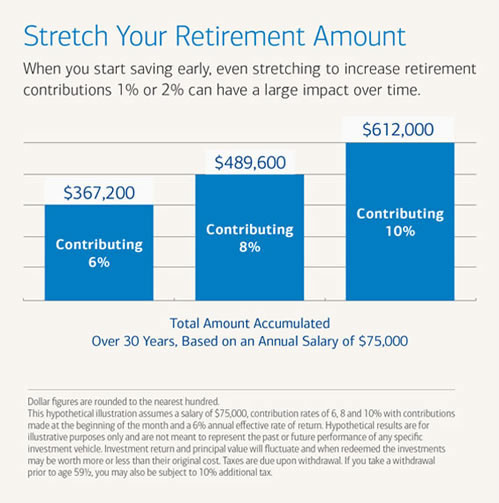Nowadays, young people understand the meaning of hard work. They also know that with hard work, substantial amounts of money can be made. So, in today’s society, you tend to see individuals jump into the workforce as young as 15 years old. Although most are probably working in order to support their fashion and entertainment habits, there are a few that are considering their future by saving.
For those individuals who become employees at a corporation (or any company that offers a 401K retirement plan), it is best to begin saving as early as possible. The sooner you start putting portions of your paycheck into a retirement account, the greater chances you’ll have at accumulating a huge chunk of money by the time you retire. Of course, this also depends on how much of your paycheck you have deducted each month. Most investment experts will advise people to transfer no less than 6 percent of their paycheck(s) to a retirement account. Percentages less than that will take a much longer time to grow, especially if you wait until you are in your late 20s/early 30s to start saving.
To assist young adults with their savings plan, here are several ways to start stacking dough for retirement:
1. Pay yourself first.
“Treat your retirement savings as a monthly expense,” suggests Debra Greenberg, director, IRA Product Management at Merrill Lynch. “Take that money off the top of your income and not from what’s left at the end of the month.” Then take a look at your budget to identify areas where you can cut back to free up more money to save. Paring down your expenses may not be as difficult as you think, Greenberg says. Try eating out less, she advises, and look for better deals on your cable or cell-phone service. Those savings can really add up.
2. Consider an IRA.
If your employer doesn’t offer a 401(k) plan, or if you’re contributing the maximum and want to save more, you can still invest in a traditional or Roth IRA (see the chart below for contribution limits).
For a Roth IRA, you contribute after-tax dollars, and you won’t pay federal tax on your earnings when you withdraw them at retirement if they’re taken as a qualified distribution. Note, however, that state tax may apply.
For a traditional IRA, you may be eligible for a tax deduction now, but you’ll be taxed when you withdraw the assets later. This can be a big benefit if you’re currently in a tax bracket that’s higher than the level that you believe may apply during your retirement, when you’ll have to pay tax on withdrawals. Ask a tax advisor which IRA is right for you.
3. Enroll in a 401(k) if you can.
If your employer offers a 401(k), enroll as soon as you can to take advantage of the benefits. In an employer-sponsored plan, your contributions are automatically deducted from your paycheck, helping you maintain the discipline to keep contributing. In addition, some employers offer a Roth 401(k), which can be especially good for young investors. Although contributions to a Roth are taxed, withdrawals during retirement won’t be if taken as qualified distributions, and your tax rate now is likely to be lower than it is when you take money from the account. And if you have a traditional 401(k), your contributions are taken from pretax dollars.
Many employers will match a certain percentage of your contributions, so at a minimum, try to contribute enough to earn the full match. “An employer match is part of your compensation, so don’t leave that money on the table,” says Vale. And if you can, contribute the maximum amount allowed. See the table above for the current contribution limits.
4. Increase your contributions whenever you can.
While it helps to contribute whatever you can, especially as you’re starting out, some say that contributing as much as 15% to 20% of your income toward retirement may make sense. It can seem like a lot, but future costs of health care and inflation will likely require more than you think. If you can’t contribute that much right now, stretch as far as you can, and make a commitment to increase your contribution when you get a raise or pay off a large expense. Even increasing it 1% or 2% regularly will add up over time. For 401(k) contributions, check to see whether your employer offers automatic increases.
5. Be sure to factor in fees.
Fees are a normal part of investing but will vary from investment to investment, so consider them carefully as you make your choices. You may be holding these investments for many years, and high fees could diminish your returns over time.
6. Consolidate to simplify.
It’s much easier to keep track of your retirement funds and monitor an overall asset allocation when all of your retirement accounts are in one place. If you’ve left retirement funds in previous employers’ 401(k) plans, you may want to consider rolling them over into an IRA or your new employer’s 401(k). Some employers pass along administration and service fees to their 401(k) participants, which may mean that you can invest in particular funds less expensively through an IRA than you can in a former employer’s 401(k). An IRA may provide you with more investment choices.
7. Balance retirement plans with your other savings goals.
Saving for retirement is important, but so are other goals, such as creating an emergency fund and preparing to pay for a child’s education. If you can balance your retirement goal planning while still enjoying today, you won’t be tempted to try to cover expenses by dipping into your retirement savings—something you really don’t want to have to do. Usually if you’re under age 59½ and withdraw retirement account funds, you’ll have to pay taxes on the amount you withdraw, along with a 10% additional tax. Ask your tax advisor about provisions for using funds for education or the purchase of a home, but be sure to also consider how withdrawing those funds can affect your retirement savings.
Once you have established a retirement savings strategy that makes room for your other financial priorities, you’re on your way. Stick to your strategy, and monitor it regularly—at least every six months—to be sure your strategy aligns with your goals as they evolve. By the time you retire, you’ll be glad you started saving as much as you did as soon as you could.
For more information on saving for retirement, go to www.Merrilledge.com.




